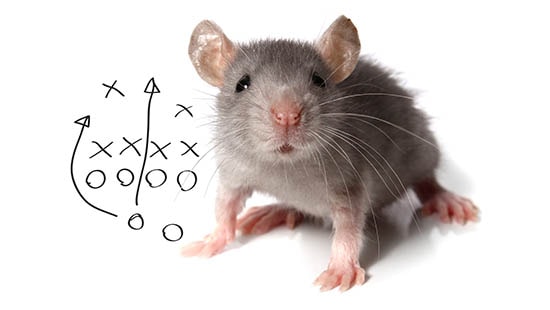A Winning Playbook for Rodent Defence and Food Safety

The Science Behind Commercial Rodent Control
Rodents can be a major problem for food and beverage processing facilities any time of year, but the adverse conditions of winter can accelerate the problem. During the cold months, mice that lived outdoors throughout the temperate months enter buildings in search of food and warmth.
Although the challenges of rodent control for food processing plants are not new, the success of control efforts continues to increase in efficacy as research reveals new understandings of rodent behavior. This is because the more we can understand rodents and their behavior, the better we can apply this knowledge to commercial rodent control and the winning playbook to apprehend them in their tracks.
Rodent Defence
There are two findings from Ecolab scientists that have significant impact on rodent control success:
- The behavioral differences between a rodent’s first venture into a new environment and once they become established.
- The “force field” impact of rodent whiskers (or vibrissae) that play an important role in their movement and search behaviors. When a rodent enters a new environment, its first instinct will be to find a place to hide from where it can scope out its new surroundings. Additionally, while it is often said that rodents have poor vision, this is true only in relation to human eyesight in the light. They actually have an impressive ability to see contrast and shadows in the dark and they use this to find shelter.
“The high-contrast hole is a big attractant for mice in new situations,” says Ecolab Corporate Scientist Douglas Gardner. “When they first enter a building, they will dart into holes, especially those closest to the door where they entered.”
Even during the day when its eyesight is less keen, a rodent gets around and finds holes quite easily by using its whiskers. Extending about 3.81 cm from its head, their whiskers aren’t simply hairs—they have muscles at the base and are very sensitive. So, the mouse can move its whiskers in broad sweeps, side to side, or hold them straight out in front to feel the wall against it is running alongside or the hole where it wants to go. “Their vibrissae are sensitive enough to pick up even shape and texture,” Gardner said. “So, they can use this ‘force field’ to investigate new things, recognize what it is and choose whether to go further.”
If, with all this, the rodent gets past the first defence and gets established in the building, it will have found shelter and no need to seek out additional holes. Thus, an additional control strategy needs to be implemented to focus on this new behaviour. This next layer of defence involves traps along runways and against walls, which are regularly inspected and removed if a rodent is caught.
From Ecolab Senior Entomologist Morgan Manderfield: “Integrating this research into rodent control programmes has validated Ecolab’s outside-in approach, which provides three layers of protection"
- Exterior rodent equipment to reduce the pest pressure
- Multi-catch traps inside the door as a barrier and new-entry capture
- Regular inspection of interior traps for quick reaction and removal
Intelligent Rodent Monitoring System
Once mice, rats or other pests infest your facility, it can be hard to discover where they’re hiding. Our remote rodent monitoring system pinpoints pest hot spots, and provides additional data, so your Ecolab Service Specialist can take swift, insight driven action.
Employees–Your First Defence Against Rodents
Because rodents are prolific breeders and rarely seen during the day or when operation is in full swing, an infestation can develop quickly. Leverage your resources by providing this employee guide to rodent control to your staff.
Food Safety 101: Inspecting Winter Deliveries for Rodents
Winter months mean cooling weather which can significantly impact rodent behavior. When cold weather comes, use this winter rodent food-safety checklist.



